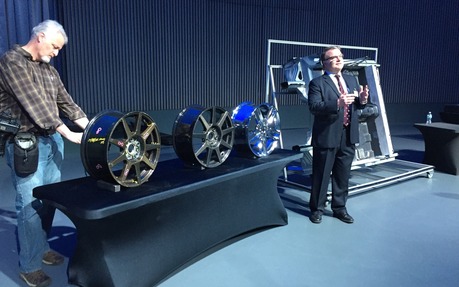Inside GM's Future Plans: Laser Welding and Carbon Fibre Wheels
WARREN, Michigan—The battle to make vehicles lighter is certainly a challenge, but one that goes beyond the materials used. During a recent presentation held in Michigan, it was evident that General Motors is constantly looking at options with the aim at reducing parts and simultaneously the mass of its vehicles.
In order for that to occur, you not only need the right material in the right locations, but also the technology behind it. Past technologies and systems may need to be replaced, so GM has altered and advanced its strategies in order to meet its high-reaching goals of being a leader in the lightweight vehicle space.
- Also: GM Takes Meticulous Approach to Weight Savings
- Also: 2015 Chevrolet Corvette Z06: Almost Outruns Its Shadow
“Commercial technology is great, but we realized [at GM] that maybe we need to start inventing our own technology,” said Blair Carlson, Lightweight Material Processing Lab Group Manager, Research & Development.
GM has a few patent-pending items in the works and one of those involves laser welding technology. Conventional laser welding uses a single beam that creates plenty of splatter and a lack of fine-tuned quality. In order to rectify this problem, GM has invented a dual laser beam that can be applied to aluminum, reducing splatter.
In addition, the aperture plate used for laser welding has been reshaped to shield laser reflection from all angles, allowing workers to use the plate for 3000-plus cars, as opposed to the conventional flat plate system that had to be replaced after only 30 cars, causing a halt to production.
Could we see carbon fibre wheels on GM cars?
GM looks to be taking a similar path as Ford has with carbon fibre wheels. Yes, Ford was well ahead with this type of wheel for its Ford Shelby GT350R—unveiled in 2015—but now GM wants to play that game, or at least they say so.
On display were a few samples that GM has been experimenting with. Naturally, carbon fibre wheels are expensive and reserved for high-priced supercars as found on the Koenigsegg One:1, but as a company who's striving to always look for lightweight materials, carbon fibre fits the bill as being the lightest of them all.
“So far, we've seen great performance from these wheels,” said William Rodgers, Light Polymer Systems Technical Fellow, Research & Development. “There's been no damage on impact, but there are still a few things we don't like and we're working on that.”
If this comes to fruition, they could appear on the Chevrolet Corvette Z06 and the Chevrolet Camaro Z/28, but nothing was mentioned on that end—they're just in experiment mode at this time.
